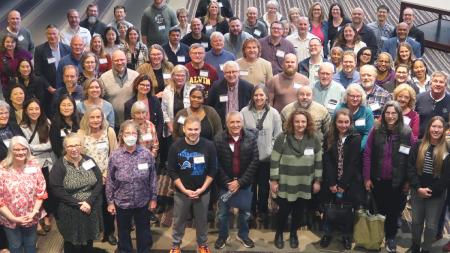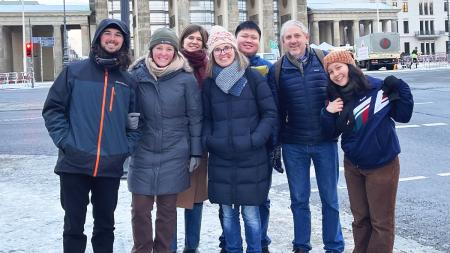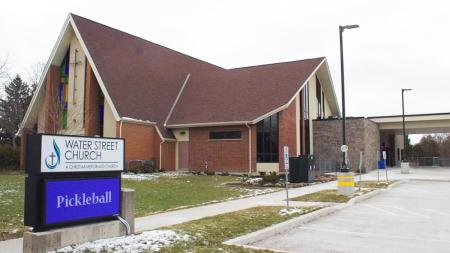Chaplaincy Ministry Celebrates 75 Years

Chaplaincy and Care Ministry
The CRC’s Chaplaincy and Care Ministry, which formally began during World War II, will launch its 75th-anniversary celebration at its annual conference meeting June 9-11 at Calvin College in Grand Rapids, Mich.
Former directors of the Chaplaincy and Care office are invited to this year’s conference, which will focus on the theme “Spirituality and Psychology – Duality or Dichotomy?” The conference, which coincides with the opening of Synod 2016, will wrap up with a special worship service at noon on June 11.
“We’re going to officially kick off our anniversary at this Chaplain’s Conference 2016, and it will continue during the next year until Synod 2017,” said Rev. Ron Klimp, director of the Chaplaincy and Care office.
The yearlong celebration will mark the history of a ministry that actually goes back more than 100 years to 1913, when informal chaplaincy began at Bethesda Sanatorium in Denver, Colo., and at Pine Rest Christian Hospital in Grand Rapids, Mich..
The informal history of this ministry also includes the formation of a chaplaincy committee for “the Welfare of our Soldiers” in 1917, when the CRC began providing chaplains for the military during World War I, said Klimp.
But the formal beginning of the current ministry office, he said, traces to 1942.
“That was when the denomination decided to form an office with a director of chaplains,” said Klimp.
“By then, World War II was going on, and the military wanted an endorser for every faith group. That way we saved the military the task of sorting through who was for real as a chaplain and who wasn’t.”
As it turns out, CRC chaplains who served in the war had an unexpected impact on ministry in the CRC.
That is because, with the outbreak of World War II, there was a concerted effort for chaplains to meet the spiritual needs of “our boys” serving around the globe, says a history of CRC chaplaincy.
“However,” adds the history, “those early military chaplains encountered a major problem.” CRC members serving in the military were often so scattered that the CRC chaplains “had none or only one” in their posted area.
Consequently, CRC chaplains found themselves responding to the needs of young men and women from a variety of faith communities during the war.
“When the War ended, returning chaplains brought home a concept of ministry that significantly expanded the notion of ministry” to include people “beyond the boundaries of our own heritage,” says the history.
As the role of ministry grew after the war, so too did the process of determining standards and providing credentials for chaplains.
“We saw the endorsement process grow as standards were developed for chaplains who wanted to serve in other areas,” said Klimp.
Today, as the office approaches its 75th birthday, the CRC has 140 chaplains. They serve in jails and prisons, hospitals, hospice care facilities, nursing homes, mental health facilities, and even in the workplace.
Chaplains also work as supervisors and clinical pastoral education supervisors and trainers, and they work in many branches of the military, frequently in high-level positions, said Klimp.
“The name of the CRC is surprisingly well known in the military,” Klimp added.
“We have had at least six chaplains serve in the Pentagon. Two are currently serving in the Army’s chaplain’s training school. We had one chaplain who recently served as the Commander of the Pacific arena for Army chaplains.”
Increasingly, said Klimp, chaplains are also working in businesses and corporations as it becomes clear that chaplains are well-suited to address the various needs of both employers and their employees.
As the field of chaplaincy expands, he is seeing more and more seminary graduates applying to serve in chaplaincy ministry, said Klimp. Currently, there are 76 inquirees or applicants waiting to move through the endorsement process.
“In the past, about 10 percent of the graduates from Calvin Seminary were serving as chaplains. Now that is pushing 15 percent.”
Leading to the interest, said Klimp, is the fact that chaplaincy has gained a higher profile and has become more attractive as a field in which graduates can serve in a professional and rewarding capacity.
In addition, for various reasons it is getting harder for graduates to find jobs in churches. “What we’re seeing is that interest in chaplaincy is at an all-time high,” said Klimp.
Referring broadly to where chaplains from various denominations serve today, Klimp said, “We see chaplains popping up everywhere. They are in police and fire departments, serve as chaplains for professional sports teams, serve on college campuses and in harbor ministries, and are even on the NASCAR circuit.”
Note: More information can be found at crcna.org/chaplaincy or by calling the Chaplaincy and Care Ministry office at 616-223-0844.


